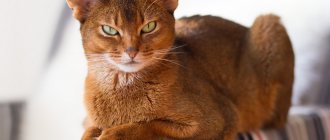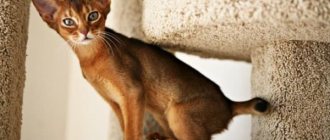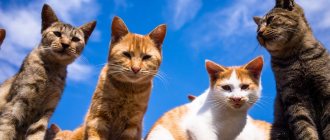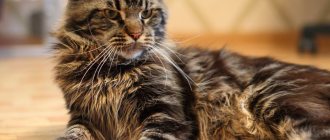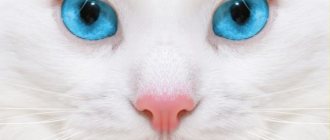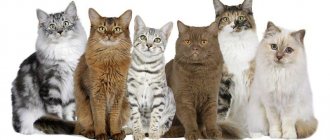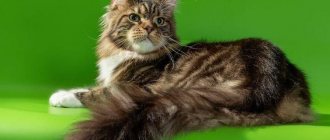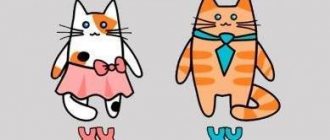Home » Cat Breeds
Sweet plush British cats, the only owners of “Cheshire” smiles among the entire cat tribe, resemble soft toys, and especially bear cubs. The standard of this breed allows a large number of colors (according to the latest data, more than sixty). Chocolate color is relatively new and still rare.
- 2 What is color and how new colors are developed
- 3 History of the breeding of British chocolate
- 4 Chocolate color standards for the British
4.1 Table: EMS encodings according to international standards WCF and FIFe
- 7.1 Video: British chocolate kitten
Havana brown
This is a relatively young breed that appeared in Europe in the 19th century. Great Britain is considered its homeland. Local breeders decided to breed an animal whose body would be covered with chocolate-colored fur. To do this, they crossed representatives of several different breeds, including Russian Blue, brown Siamese and domestic black cats. In the 50s of the 20th century, these animals were brought to America. A few years later they were officially recognized as an independent breed.
Havana Browns are charming brown cats with a playful disposition and a gentle voice. Their weight ranges from 4-6.5 kilograms. The elongated head has raised whisker pads, bright green eyes and forward-leaning ears. The animal has a strong, muscular body with soft, shiny fur, the color of which varies from red-brown to warm chocolate.
Features of color
The formation of color is a complex biochemical process that begins in the embryonic stage of embryonic development. The color of a future kitten's fur depends on the interaction of dozens of genes.
- Chocolate color is one of the forms of black, for which the B gene (black) is responsible. In combination bb it gives the color range of a brown monochrome, capable of taking on different tones.
- Next, the D gene enters the process. In the dominant form, it blocks any lightening, but in the recessive version, dd opens the way for a change in the color of the main pigment.
- The bb (brown) allele and the dominant D gene are chocolate color. When the combination bb+dd occurs, the coat lightens and turns purple.
- Black always dominates brown.
- Within colors there are also divisions into tones. Dark chocolate is formed by the b allele, and the lighter cinnamon (cinnamon) received the b index
- Option b partially suppresses b1, making color fixing a very difficult task. Therefore, kittens change color over time, and only in an adult animal can one accurately determine the color of the coat.
- In nature, cats have two coloring pigments - black eumelanin and red pheomelanin. But the first one has two additions - brown (dark chocolate) and cinnamon (cinnamon color). The color saturation of the hair is affected by the shape of the dye capsules and the density of their arrangement in each hair.
Experienced breeders always accurately determine what colors cats will have in their litter. Brown color is considered rare and complex, but in some cases it predictably appears when breeding chocolate cats.
This is interesting! Once upon a time, felinologists tried to get brown offspring from red (ginger) cats. But the experiments had to be stopped due to unstable results. Only some varieties of black cats give birth to chocolate babies.
Persian cat
These magnificent animals have a very long history. Their development began around the 16th century. The first representatives of this breed came to Italy from one of the Persian provinces. Subsequently, they gained extraordinary popularity among European breeders and quickly spread throughout the continent.
These animals have a memorable appearance. The average weight of Persians reaches 6-8 kilograms, but larger individuals are also found in nature. On a rounded head with thick cheeks, strong jaws, a powerful chin and a convex forehead, there are small ears, expressive shiny eyes and a short, upturned nose. The large body with a wide back and massive chest is covered with thick long hair. As for color, the standard allows several options. But black, white, red, blue, cream and brown cats are especially popular.
English names
Sweet-sounding and beautiful nicknames of English origin are popular among all pet lovers. They “look” very gracefully on representatives of the cat family and are perfect for chocolate beauties and beauties.
Male names:
- Archie;
- Billy;
- Benny;
- Bean;
- Binks;
- Buddy;
- Brian;
- Brighton;
- Dave;
- Dick;
- John;
- Joel;
- Jas;
- James;
- Zach;
- Ethan;
- Kevin;
- Clyde;
- Clark;
- Lionell;
- Michael;
- Marilyn;
- Matt;
- Matthew;
- Murphy;
- Nick;
- Austin;
- Ozzy;
- Pipe;
- Floor;
- Peter;
- Randall;
- Rick;
- Ron;
- Steve;
- Sam;
- Tim;
- Volume;
- Walt;
- Frank;
- Harley;
- Chase;
- Chuck;
- Eddie;
- Angel.
Female names:
- Andi;
- Iris;
- Becky;
- Brittany;
- Barbie;
- Wendy;
- Winona;
- Valley;
- Gabby;
- Grace;
- Dolly;
- Deyzhi;
- Jodie;
- Zoe;
- Kelly;
- Kylie;
- Catherine;
- Kitty;
- Katie;
- Lizzie;
- Lisa;
- Meryl;
- Mandy;
- Miley;
- Maggie;
- Nora;
- Paris;
- Priestley;
- Singing;
- Polly;
- Prudence;
- Reese;
- Riley;
- Rand;
- Sally;
- Sue;
- Sadie;
- Tera;
- Trixie;
- Trisha;
- Tyra;
- Franny;
- Phoebe;
- Heidi;
- Hayley;Cheryl;
- Shannon;
- Sharon;
- Ashley;
- Emily;
- Ellie;
- Andrea.
Young Prudence
Shorthair exotics
These unpretentious beautiful animals are close relatives of the Persians. They were bred in the 1960s through the efforts of American breeders.
Shorthaired exotics are large cats with a strong, muscular body of a square format, under which there are short, thick limbs. The round head with convex cheeks and a massive lower jaw has widely spaced eyes, small ears and a miniature upturned nose. The entire body of representatives of this breed is covered with thick, silky short fur with dense undercoat. As for the color, it can be anything. But the most common ones are red, blue, white, cream and brown-white cats.
Shorthaired exotics have a calm, friendly disposition. They do not tolerate loneliness well, but they will never bother you with tenderness. Thanks to their natural balance and serenity, these non-aggressive animals easily adapt to any conditions.
Care and maintenance
Havana is an unpretentious cat; he does not need specific conditions. To maintain a neat appearance, it requires minimal hygienic care:
Scottish cats
These animals appeared as a result of a natural genetic mutation. It occurred more than half a century ago in an ordinary white cat named Susie. Subsequently, offspring were obtained from her. One cat from this litter ended up in the family of shepherd William Ross. It was she who became the ancestor of the new breed.
Scottish cats are animals with a strong body, a wide chest and a strong neck. On a round head with a well-developed chin and pronounced whisker pads, there are large eyes and a neat nose. The ears of representatives of this breed can be either straight or downward. The entire body of these animals is covered with a beautiful thick six. As for color, many options are allowed here. Despite this diversity, black, blue and brown Scottish cats are the most common.
Representatives of this breed are distinguished by their unobtrusive, affectionate character. They are extremely clean and can live even in a small apartment. At a young age, these animals are very active and playful. But over time they become more phlegmatic.
"Delicious" nicknames
Gastronomic nicknames are an interesting option for furry pets with brown fur. We offer you some ideas for inspiration:
- Icecream;
- Almond;
- Anise;
- Amaretto;
- Brownie;
- Baileys;
- Brandy;
- Wispa;
- Whiskey;
- Granita;
- Guinness;
- Genie;
- Ginger;
- Iris;
- Ginger;
- Toffee;
- Coffee;
- Cappuccino;
- Canella;
- Cocoa;
- Cola;
- Klav;
- Curry;
- Latte;
- Mint;
- Minta;
- Melissa;
- Steam table;
- Mousse;
- Mocha;
- Nougat;
- Nats;
- Piper;
- Raizn;
- Spicy;
- Sweetie;
- Twix;
- Hershey;
- Chokopay;
- Eclair;
- Espresso.
Surprised Muffin
British cats
These animals are distinguished by their strong build with a wide chest and short legs. The round head with well-defined cheekbones has erect ears and large eyes. The entire body of the British is covered with beautiful short fur with a thick undercoat. Representatives of this breed often include tortoiseshell, red, lilac, cream, black and dark brown cats.
The British are very affectionate and clean animals that quickly get used to their owner. At the same time, they calmly tolerate short separation from the owner. These calm, balanced cats do not require complex care. They are not picky when it comes to food, and happily eat both industrial and natural food.
White breeds of cats and male cats with photographs and names: photos, character description
White cats are very beautiful and elegant. According to the standards, white breeds are not allowed any spots or impurities. This color can only be obtained by crossing purebred breeds that have not been mixed.
White coat color in cats can be due to various reasons:
- due to a specific gene associated with deafness (seen in cats with green or blue eyes)
- due to albinism, when animals have no coat pigmentation, and their eyes and skin have a pinkish tint
- due to the presence of the gene that determines white spotting. Sometimes there are a lot of such white spots, they merge together, and the cat turns white
Many breeds can have a white coat:
- Persian
- Devon Rex
- Maine Coons
- British
We present the most striking representatives of the snow-white color:
Turkish Angora is an ancient aristocratic breed. It has soft silky fur and greenish or blue eyes.
Cat details:
- very smart. Can learn to use light switches and open the refrigerator door
- active and mobile
- inquisitive
- don't like loneliness
- usually become attached to one person
- love attention to their person
- enjoy playing with toy or live mice
Turkish Angora
Khao Mani is a short-haired cat native to Thailand. This fairly ancient breed was officially registered quite recently. An extremely graceful snow-white animal that has the following features:
- curiosity
- mind
- playfulness and mobility
- love for the owner, whose company they simply adore
- trusting even towards strangers
- highly social (therefore, it is not recommended to have such a cat if you do not have other cats)
Khao mani
The Foreign White is a shorthaired cat, the result of crossing a Siamese and a European Shorthair. They have a graceful body and blue eyes. Moreover, animals are endowed with excellent hearing. The breed is quite rare.
Character:
- highly intelligent
- social
- friendly
- independent
- freedom-loving
- quite talkative, have a loud voice
- active, love active games
Foreign white
The Turkish Van is a large cat with semi-long white hair with almost no undercoat, with colored spots on the tail, ears and face.
Key Features:
- mobile
- playful
- inquisitive
- swim well, they like water fun
- love affection, although they can be wayward
- usually becomes attached to one of the family members
Turkish van
Yorkie chocolate cat
This is a very young breed, which for a long time remained unrecognized by professional felinologists. It was registered only in 1983 and quickly gained enormous popularity. Today, European, American and Canadian breeders are engaged in its breeding.
These animals have a long, muscular body with a thin neck and slender limbs. On a round head with a wedge-shaped muzzle, there are not too large oval eyes and large ears. The entire body of representatives of this breed is covered with soft, silky fur with a glossy sheen. As for color, only lilac and brown cats are allowed by the standard.
These graceful animals have a cheerful, active disposition. They quickly become attached to their owners and are quite trainable. These curious cats need constant human interaction. They are extremely careful and completely devoid of aggression.
Famous, popular plush breeds of cats and cats: photos, character description
Some cats have short but very thick fur that gives them the appearance of a plush toy. This fur is extremely pleasant to the touch. The most famous and popular are these “buns”.
British Shorthairs are bright representatives of the “plush” breed. Strong, serious animals, with a round head and serious eyes. These cats have remarkable properties:
- calm
- clean
- endowed with high intelligence
- affectionate
- loyal to their masters
- rarely bite or scratch
- They easily tolerate loneliness. Ideal for people who are not often at home
- don't like to be squeezed
- gets along easily with other pets
- unpretentious in food
British Shorthair
The British chinchilla is a calm and inactive cat, bred as a result of crossing the British and Persian breeds.
Characteristics:
- very lazy, prefer to lie down all day
- affectionate and gentle
- they need constant attention from their owners
- easy to adapt and learn
- patient
- need their own corner and do not like it when people encroach on their territory
- not aggressive, but quite stubborn
British chinchilla
The exotic shorthair is a pussycat that captivates people's hearts with its naive face and plush fur. The breed was created by accident, but quickly gained popularity. These cats are similar to Persian cats, only with short hair.
Exotics have an almost ideal character:
- good-natured and affectionate
- curious
- lazy couch potatoes
- do not make noise, preferring quiet games with toys
- devoid of aggression, in case of an incorrect attitude they simply leave offended
- indifferent to strangers
Exotic Shorthair
Scottish Straight (Scottish Straight) is a fluffy, strong representative of the Scottish breed, endowed with a wonderful character:
- friendly, non-aggressive
- quickly becomes attached to all family members
- calm and sedate
- afraid of heights
- cannot tolerate coercion or being held in arms by force
Scottish straight
Burmese cat
Representatives of this breed have a very long history. The first mentions of them are found in eastern chronicles dating back to the 15th century. Supposedly, they lived in temples and were considered talismans for the rich of Bangkok. They came to Europe in 1930 thanks to Dr. Joseph Thompson. It was he who was sent such an unusual gift from Southeast Asia.
Today there are two varieties of Burmese cats - European and American. They differ from each other in the structure of the skeleton and the shade of the coat. The European Burmese has a graceful body with a thin, long neck and a rounded, wedge-shaped head. Representatives of the American branch are distinguished by a strong physique with well-developed muscles and a wide muzzle. Regardless of the type, the entire body of these animals is covered with short, shiny, silky hair. As for color, the standard allows lilac, blue and brown cats, photos of which can be seen in today’s publication.
Both American and European Burmese are distinguished by their friendly and accommodating character. They quickly get used to their owners and do not tolerate loneliness well. They are cheerful and playful, like little kittens. But if necessary, they are able to show sensitivity and delicacy.
Breed defects
Chocolate breed cats are very healthy and are extremely rarely exposed to any diseases, especially if they have received all the necessary vaccinations. The maximum that can appear is caries, which can be avoided if you take care of your cat's teeth, and worms - any animal is susceptible to them, the problem is solved with the help of a tablet. The breed has no hereditary diseases, but has a strong immune system.
The standard color of the breed for exhibitions is chocolate or lilac. Up to 18 months, kittens are allowed a small amount of white fur, but adult cats should have a uniform color.
If after one and a half years the cat still has stripes or white spots, it will not be able to take part in exhibitions; the presence of white is considered a color defect.
Chantilly-Tiffany
This is a relatively rare breed that received official recognition in 1979. Chantilly Tiffanys are slender, graceful cats with a wedge-shaped head, bright eyes and wide-set round ears. The entire body of these animals is covered with elegant, silky fur, completely devoid of undercoat. As for color, previously these were exclusively brown cats. But the modern standard allows for the presence of lilac, blue or spotted-striped skins.
These playful and friendly animals quickly become attached to their owners. At the same time, they do not require constant attention and complex specific care. Chantilly Tiffanys often purr in a quiet, gentle voice, reminiscent of a dove's coo.
"Fragrant" nicknames
An original solution is to give the four-legged pet a name that is consonant with the name of a classic or fashionable modern fragrance. You can also “imprint” the name of a perfumery and cosmetics brand in your nickname.
- Azzurra;
- Guerlain;
- Dolce Vita;
- Dolce;
- Givenchy;
- Zhador;
- Cacharel;
- Klima;
- Kenzo;
- Lancome;
- Mugler;
- Noah;
- Opium;
- Poison;
- Sparklin;
- Trezor;
- Tuberose;
- Chance;
- Chanel;
- Ermes;
- Angel;
- Herrera.
"Scottish" nicknamed Chanel
Devon Rex
These long-eared cats are more reminiscent of fairy-tale elves. Their story begins in the middle of the 20th century. It was then that people living near one of the English mines accidentally found an unusual cat with curly fur, which became the ancestor of a new breed.
These are large, muscular animals with a broad chest, thin legs and a long tail. On the large head of the Devon Rex there are huge ears that look like locators, and expressive elongated eyes. The entire body of representatives of this breed is covered with soft, dense hair with wavy curls. The most common cats are white, honey, black, lilac and brown.
They all have an active, energetic character. They love outdoor games and love to jump on high cabinets.
How many years do they live?
In addition to the standard procedures for cleaning eyes, ears, and trimming claws, it is recommended to periodically take the cat to the veterinarian for a health assessment and more painstaking care procedures. In the absence of serious diseases, a cat can live up to 15 years, but there have also been long-livers who have delighted their owners for more than 20 years.
York chocolate cat breed
